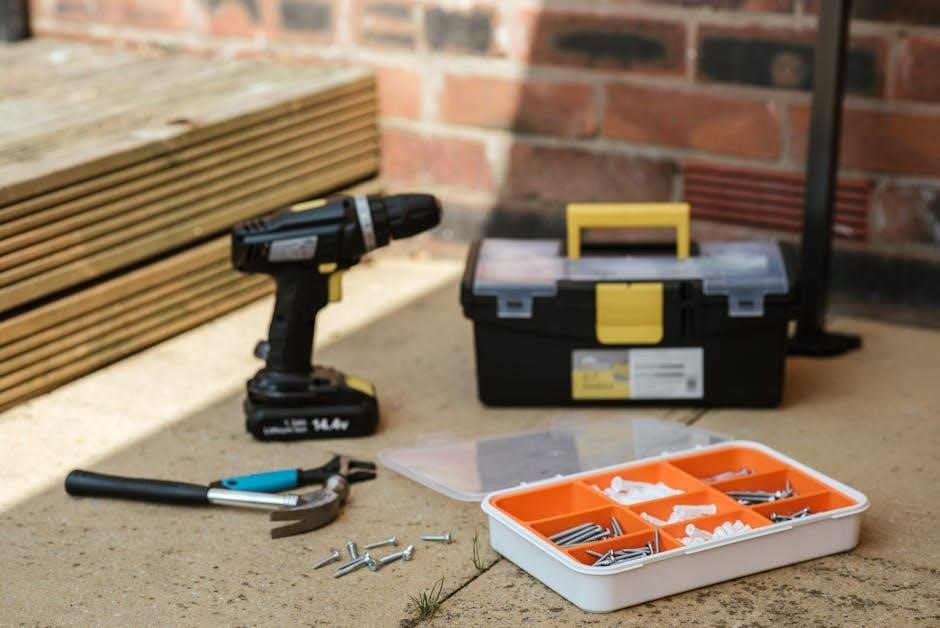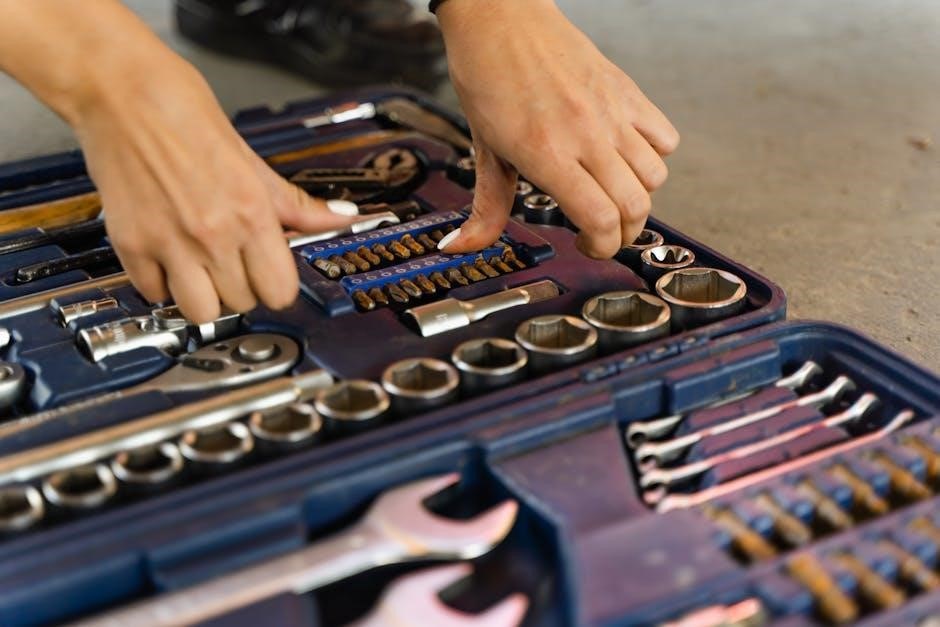A manual dumbwaiter kit offers a cost-effective, energy-efficient solution for moving items between floors in homes, ideal for multi-level spaces. Versatile and easy to install, these kits provide a practical way to transport food, laundry, or other items, enhancing convenience and functionality in residential settings.
Definition and Purpose of a Manual Dumbwaiter
A manual dumbwaiter is a cost-effective system for transporting items between floors, ideal for multi-level homes. It enhances convenience and functionality with minimal installation effort, offering customization.
What is a Manual Dumbwaiter?
A manual dumbwaiter is a simple, non-motorized system used to transport items between floors in a home. Typically consisting of a carriage, pulleys, and a rope or chain, it operates manually, requiring users to pull the load up or down. This traditional design is cost-effective, energy-efficient, and ideal for smaller loads, making it a practical solution for multi-level homes seeking to enhance convenience without significant installation or maintenance costs.
Historical Background and Modern Applications
Manual dumbwaiters trace their origins to 19th-century homes, where they were used to move goods between floors. Originally simple rope-and-pulley systems, they were essential in large households. Today, modern applications include transporting food, laundry, and other items in multi-level homes, outdoor decks, and even commercial settings, offering a reliable, low-cost alternative to automated systems. Their timeless functionality continues to make them a valuable addition in both traditional and contemporary spaces.

Key Components of a Manual Dumbwaiter Kit
A manual dumbwaiter kit typically includes a structural frame, pulley system, control mechanisms, and safety features. These components ensure smooth, secure operation for moving items between floors efficiently.
Structural Frame and Pulley System
The structural frame of a manual dumbwaiter kit provides the backbone for the system, typically made of durable materials like steel or wood. The pulley system, often incorporating ropes or chains, enables smooth vertical movement. DIY solutions, such as repurposing garage door openers, highlight the adaptability of these components. Proper alignment and material choice ensure reliability and safety, making the frame and pulley system critical for efficient operation in residential settings.
Control Mechanisms and Safety Features
Manual dumbwaiter kits include control mechanisms like handles or cranks for easy operation and safety features such as automatic brakes to prevent uncontrolled movement. These mechanisms ensure smooth operation, while safety features like load sensors and emergency stops enhance user protection. Proper installation of these components is crucial to prevent accidents and ensure reliable performance over time.

How to Build and Install a Manual Dumbwaiter
Building a manual dumbwaiter can be a cost-effective and rewarding DIY project. Start by gathering materials such as a pulley system, a frame, and a handle. Follow online tutorials or kits for guidance. Ensure safety by installing brakes and testing weight limits. Measure and plan the installation space carefully to fit your home’s layout. Consider using pre-made kits for convenience or repurpose items like garage door openers for a budget-friendly solution; Always check local building codes and regulations before starting your project.
Step-by-Step DIY Installation Guide
Begin by planning the route and measuring the space for your dumbwaiter. Assemble the frame and pulley system according to the kit instructions. Install the tracks between floors, ensuring proper alignment. Attach the handle and rope system, then test the mechanism for smooth operation. Secure the dumbwaiter car with safety brakes and install access doors on each level. Finally, load-test the system to ensure it functions safely and efficiently, making adjustments as needed for optimal performance.
Tips for Customizing Your Dumbwaiter Design
Customize your manual dumbwaiter by choosing materials like wood or metal to match your home decor. Add a finishes such as paint or varnish for a polished look. Consider integrating smart home features for remote operation. Ensure the design aligns with your space constraints and load requirements. For outdoor use, weatherproof the system. Always prioritize safety with secure braking mechanisms and durable construction to handle regular use effectively and efficiently.

Uses of Manual Dumbwaiters in Residential Settings
Manual dumbwaiters are ideal for transporting food, dishes, and laundry between floors in homes, offering a practical solution for multi-level living and enhancing household efficiency.
Transporting Food and Laundry
Manual dumbwaiters are perfect for moving meals and dirty laundry between floors, streamlining household tasks. They save time and effort, especially in multi-level homes, by eliminating the need for carrying items manually. This feature is particularly useful in homes with kitchens on upper levels, allowing food to be sent directly to dining areas. Similarly, laundry can be efficiently transferred to and from washing machines, enhancing overall convenience and productivity.
Space-Saving Solutions for Multi-Level Homes
Manual dumbwaiters are ideal for multi-level homes, offering a compact solution to transport items without occupying valuable floor space. Their slim design allows installation in tight areas, such as between walls or in small shafts, making them perfect for homes with limited room. This space-efficient system minimizes clutter and simplifies moving items like groceries or laundry, ensuring convenience and practicality in even the most constrained living spaces.

Safety Considerations for Manual Dumbwaiters
Ensure proper installation and secure the system to prevent accidents. Adhere to weight limits and install safety mechanisms like brakes and secure roping to avoid mishaps.
Load Capacity and Weight Limits
Manual dumbwaiter systems typically have load capacities ranging from 50 to 200 pounds, depending on design and materials. Exceeding these limits can cause mechanical failure or safety hazards. Proper installation ensures structural integrity, while regular inspections maintain reliability. Adhering to specified weight limits ensures smooth operation and longevity of the system, preventing potential breakdowns or accidents.
Proper Maintenance and Inspection
Regular maintenance is crucial for ensuring the longevity and safety of a manual dumbwaiter. Inspect pulleys, ropes, and brackets for wear and tear, lubricating moving parts to prevent friction. Check load limits and ensure smooth operation by tightening loose components. Address any issues promptly to avoid mechanical failures. Scheduled inspections help maintain efficiency and prevent accidents, ensuring reliable performance over time.

Advantages of Manual Dumbwaiters Over Automatic Systems
Manual dumbwaiters offer cost-effectiveness, energy efficiency, and reliability. They require low maintenance, are simpler to install, and provide a practical solution without the need for complex automation systems.
Cost-Effectiveness and Energy Efficiency
Manual dumbwaiters are budget-friendly, requiring minimal installation and maintenance costs. They operate without electricity, reducing energy consumption and lowering utility bills. DIY kits, like the $300 option, offer affordability for homeowners seeking to enhance convenience without financial strain. This eco-friendly solution is ideal for those prioritizing cost savings and sustainability in multi-level homes.
Reliability and Low Maintenance
Manual dumbwaiters are known for their durability and minimal upkeep requirements. With fewer mechanical components compared to automatic systems, they experience less wear and tear. Regular lubrication of pulleys and checks ensure smooth operation. Homeowners appreciate their dependable performance, making them a hassle-free choice for years of reliable service in transporting items between floors.
Maintenance and Repair of Manual Dumbwaiters
Regular inspections, lubrication of pulleys, and ensuring proper alignment are key to maintaining a manual dumbwaiter. Addressing issues promptly prevents major repairs and extends longevity.
Regular Checks and Lubrication
Regular inspections ensure smooth operation of manual dumbwaiters. Lubricate pulleys and cables every six months to reduce friction. Check for wear on ropes and replace them if frayed. Inspect brake systems to ensure safety. Clean tracks and guide rails to prevent dust buildup. Tighten loose screws and bolts to maintain stability. These simple steps help prevent malfunctions and extend the lifespan of your dumbwaiter, ensuring reliable service for years to come with minimal effort and cost.
Troubleshooting Common Issues
Common issues with manual dumbwaiters include rope fraying, pulley misalignment, or brake malfunctions. Inspect ropes for wear and replace if damaged. Adjust pulleys to ensure proper alignment. Lubricate moving parts regularly. If the dumbwaiter stops moving, check for blockages or overloading. Addressing these issues promptly prevents further damage. Consulting user manuals or seeking professional help when needed ensures your system runs efficiently and safely, minimizing downtime and extending its operational life effectively.
Case Studies and User Experiences
Homeowners report successful installations, praising manual dumbwaiters for simplifying tasks like transporting laundry and food between floors. DIY projects highlight cost savings and improved home functionality effectively.
Successful DIY Projects and Installations
Many homeowners have successfully installed manual dumbwaiters, transforming their spaces with minimal cost. A DIY project using a garage door opener created a functional dumbwaiter for under $300. Others have customized designs to fit specific needs, such as outdoor setups for moving items between decks or integrating natural gas BBQ areas. These installations highlight the versatility and practicality of manual dumbwaiter kits in enhancing home functionality while staying budget-friendly.
Reviews and Feedback from Homeowners
Homeowners praise manual dumbwaiter kits for their functionality and ease of use. Many report satisfaction with their ability to transport food, laundry, and other items efficiently. Users highlight the cost-effectiveness and reliability of these systems, often customizing them to fit specific needs. Positive feedback includes ease of installation, durability, and the convenience they add to multi-level homes. Overall, manual dumbwaiters are seen as practical, eco-friendly solutions for enhancing home productivity.

Future Trends in Manual Dumbwaiter Technology
Future trends include smart home integration, allowing voice or app control, and eco-friendly designs using sustainable materials like recycled steel or bamboo, enhancing efficiency and environmental appeal.
Integration with Smart Home Systems
Smart home integration transforms manual dumbwaiters into high-tech solutions, enabling voice or app control for seamless operation; Sensors can monitor load weights, preventing overloading, while automated doors enhance convenience. Integration with systems like Alexa or Google Home allows users to activate the dumbwaiter hands-free, streamlining household tasks. This innovation bridges traditional functionality with modern technology, offering a futuristic yet practical solution for multi-level homes.
Eco-Friendly and Sustainable Designs
Manual dumbwaiter kits are increasingly designed with eco-friendly materials, such as reclaimed wood and recyclable steel, reducing environmental impact. Energy-efficient systems minimize power use, aligning with sustainable living. These designs promote green building practices, offering homeowners a responsible solution for multi-level transport needs while maintaining durability and functionality. Eco-conscious options are gaining popularity as homeowners prioritize environmental sustainability without compromising on performance or convenience.
